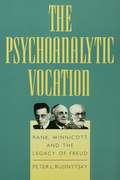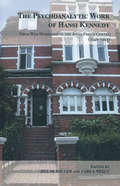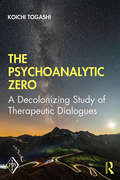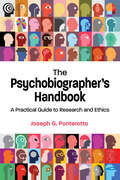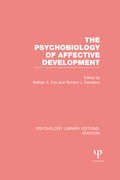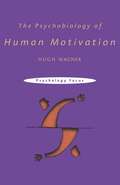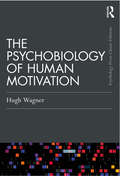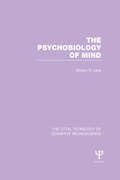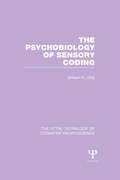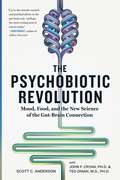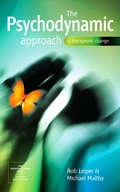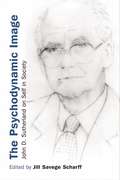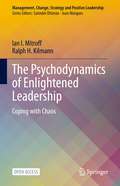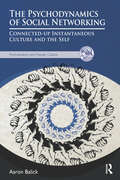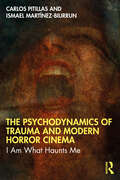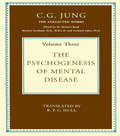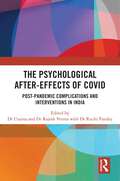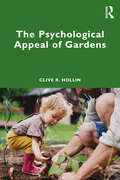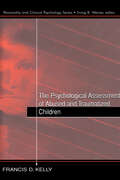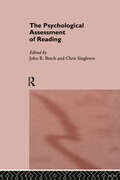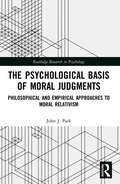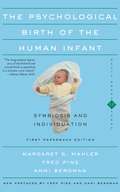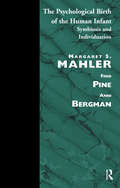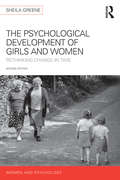- Table View
- List View
The Psychoanalytic Vocation: Rank, Winnicott, and the Legacy of Freud
by Peter L. RudnytskyObject relations, which emphasizes the importance of the preoedipal period and the infant-mother relationship, is considered by many analysts to be the major development in psychoanalytic theory since Freud. In this reinterpretation of its history Peter L. Rudnytsky focuses on two pivotal figures: Otto Rank, one of Freud's original and most brilliant disciples, who later broke away from psychoanalysis, and D. W. Winnicott, the leading representative of the Independent tradition in British psychoanalysis. Rudnytsky begins with an overview arguing that object relations theory can synthesize the scientific and hermeneutic dimensions of psychoanalysis. He the uses the ideas of Rank and Winnicott to uncover the preoedipal aspects of Sophocles' Oedipus the King. After an appraisal of the relationship between Rank and Freud, he turns to Rank's neglected writings between 1924 and 1927 and shows how they anticipate contemporary object relations theory. Rudnytsky critically measures Winnicott's achievement against those of Heinz Kohut and Jacques Lacan, the founders of two competing schools of psychoanalysis, and compares Winnicott's life and work with Freud's. Next, using both published and unpublished accounts by the psychotherapist Harry Guntrip of his analyses with W. R. D. Fairbairn and Winnicott, he probes the personal and intellectual interactions among these three British clinicians. Rudnytsky concludes by advancing a psychoanalytic theory of the self as a rejoinder to the postmodernism that is the dominant ideology in literary studies today. In two appendices he makes available for the first time an English translation of Rank's "Genesis of the Object Relation" and a 1983 interview with Clare Winnicott.
The Psychoanalytic Work of Hansi Kennedy: From War Nurseries to the Anna Freud Centre (1940-1993)
by Jill M. Miller Carla NeelyThis book presents a selection of the works of Hansi Kennedy, preeminent child psychoanalyst, whose career began with Anna Freud in the Hampstead War Nurseries and continued at the Hampstead Child Therapy Clinic (renamed the Anna Freud Centre in 1982) until retirement in 1993. Her career spanned a significant period in the development of child psychoanalysis, as her ideas foreshadowed a number of advances in theory during the period which have had a profound impact on child psychoanalytic technique.
The Psychoanalytic Zero: A Decolonizing Study of Therapeutic Dialogues (Psychoanalytic Inquiry Book Series)
by Koichi TogashiThe Psychoanalytic Zero: A Decolonizing Study of Therapeutic Dialogues is written from the unique perspective of a Western-trained Asian psychoanalyst and applies principles of Eastern philosophy to understand the psychoanalytic relationship, psychoanalytic processes, and their uses—and limitations—for alleviating human suffering. Bringing a unique Eastern perspective to a previously Western-dominated discipline and framed within the current relational and ethical trends in psychoanalysis, the book enables readers to develop a language for understanding an Eastern ethical viewpoint and explore how this language can change our awareness of psychoanalytic practice and human suffering. Chapters are devoted to the Eastern concepts of nothingness, emptiness, surrender, sincerity, silence and narrative, and issues including existential "guilt of being," trauma, contingency, informed consent, the sense of being human, and uncertainty. Discussions are illustrated and illuminated through vivid recreations and careful elaboration of therapeutic case studies with traumatized patients. The studies demonstrate the process by which patients regain a sense of being human. This enriched perspective will, it is hoped, help the analyst treat traumatized patients who are unable to relate to others, and who do not experience themselves as being human. The Psychoanalytic Zero will enrich an analyst’s sensitivity to the appearance of the moment without context—the psychoanalytic zero—which opens infinite opportunities for continued growth in a psychoanalytic relationship. It will be of great appeal to psychoanalysts and psychoanalytic psychotherapists interested in self-psychological, intersubjective, and relational theories.
The Psychobiographer's Handbook: A Practical Guide to Research and Ethics
by Joseph G. PonterottoA practical guide to conducting psychobiography, including the theory, methods, and ethical considerations required for research and writing.
The Psychobiology of Affective Development (Psychology Library Editions: Emotion)
by Nathan A. Fox Richard J. DavidsonOriginally published in 1984, this was the first volume on this topic to appear in an emerging area of study at the time. The editors were selective in choosing their contributions to the volume to ensure that both the developmental and neuropsychological domains were well represented. One of the major goals was to foster greater contact and cross-fertilization between subdisciplines that they firmly believed should be more intimately connected. The result is this title, which can now be enjoyed in its historical context.
The Psychobiology of Human Motivation
by Hugh WagnerWhy is one person motivated to create a business empire whilst another is inspired to produce a beautiful work of art? Why do some people prefer a quiet life?The Psychobiology of Human Motivation explores what directs our behaviour, from basic physiological needs like hunger and thirst to more complex aspects of social behaviour like altruism. Hugh Wagner explores the limits of biological explanations and shows how humans can influence `basic' physiological drives in order to adapt to a complex social environment.
The Psychobiology of Human Motivation (Psychology Press & Routledge Classic Editions)
by Hugh WagnerThis is a classic edition of Hugh Wagner’s influential overview of the biopsychological underpinnings of human motivation. It includes a new foreword written by Michael Richter who reflects on Wagner’s 20 years of teaching, writing and research in the field of biopsychology and promises an engaging, succinct and accessible introductory text that remains relevant and useful to students today. The Psychobiology of Human Motivation explores what directs our behaviour, from basic physiological needs like hunger and thirst to more complex aspects of social behaviour like altruism. Wagner explores the limits of biological explanations and shows how humans can influence ‘basic’ physiological drives in order to adapt to a complex social environment. An accessible, engaging resource strengthened by many applied examples, Wagner’s text continues to be integral reading for undergraduate students seeking a solid introduction to the psychology of human motivation across the social and behavioural sciences.
The Psychobiology of Mind (The Uttal Tetralogy of Cognitive Neuroscience)
by William R. UttalOriginally published in 1978, this book develops a conceptual synthesis of the field of physiological psychology, the science specifically concerned with the relationship between the brain and the mind. It was designed to elucidate the important questions under investigation, the basic intellectual and technical problems that were encountered, and the significance of the major empirical results of the time. Of equal or even greater importance is the author’s derivation of the general principles relating brain and mind that had emerged after decades of modern research into this important question. Included in the volume are historical and philosophical perspectives on the mind-brain problem as well as extensive discussions of instruments, methodology, empirical findings and theory. Here is a powerful heuristic tool that informs the reader about the concepts and ideas implicit in this science rather than simply exhaustively listing experimental results. The author does not ignore findings; he organizes them into three broad categories – localization; representation, and learning – then emphasizes the relationships among experiments. This is a book that synthesizes, integrates, and stresses concepts, principles and problems. The careful organization of the book makes it especially useful for students of brain and mind at all levels.
The Psychobiology of Sensory Coding (The Uttal Tetralogy of Cognitive Neuroscience)
by William R. UttalOriginally published in 1973, this book deals with what were, even at that time, the well-known neural coding processes of the sensory transmission processes. The book was written to demonstrate the common features of the various senses. It concentrates on the most peripheral neural aspects of the senses starting with the physical transduction process and culminating in the arrival of signals at the brain.
The Psychobiotic Revolution: Mood, Food, and the New Science of the Gut-Brain Connection
by John F. Cryan Scott C. Anderson Ted DinanWritten by the leading researchers in the field, this information-rich guide to improving your mood explains how gut health drives psychological well-being, and how depression and anxiety can be relieved by adjusting your intestinal bacteria. This groundbreaking book explains the revolutionary new science of psychobiotics and the discovery that your brain health and state of mind are intimately connected to your microbiome, that four-pound population of microbes living inside your intestines. Leading medical researchers John F. Cryan and Ted Dinan, working with veteran journalist Scott C. Anderson, explain how common mental health problems, particularly depression and anxiety, can be improved by caring for the intestinal microbiome. Science is proving that a healthy gut means a healthy mind—and this book details the steps you can take to change your mood and improve your life by nurturing your microbiome.
The Psychodynamic Approach to Therapeutic Change (SAGE Therapeutic Change Series)
by Rob Leiper Michael Maltby`It is well written and well organised and I'm sure it will be of help and interest to researchers and practitioners concerned with the therapeutic action of psychodynamic treatment' - Penelope Waite, Nurturing Potential Change is the central purpose of all counselling and psychotherapy, but how it is conceptualized and worked with varies according to the theoretical approach being used. The Psychodynamic Approach to Therapeutic Change explores the nature of psychological change from the psychodynamic perspective and describes the process through which clients can be helped to come to terms with painful experiences and develop new ways of relating. In the first part of the book, Rob Leiper and Michael Maltby look at therapeutic change in relation to psychological health and maturity. They explore what motivates people to change and also why resistance occurs. The main part of the book outlines the collaborative process that clients and therapist work through to bring about change and highlights the role of the therapist in: ] creating the conditions for clients to express their thoughts, feelings and memories ] developing clients' awareness and understanding of their psychological processes, and ] providing `containment' for the client's psychological projections. The final part of the book sets personal therapeutic change in a wider social context, linking individual change with community and organisational development. Combining core psychodynamic concepts with contemporary thinking, The Psychodynamic Approach to Therapeutic Change provides a lively and up-to-date integration of ideas on the change process which will be of great value to trainees and practicing counsellors and psychotherapists.
The Psychodynamic Image: John D. Sutherland on Self in Society
by Jill Savege ScharffThe Psychodynamic Image is the first selection of John D. Sutherland’s major papers. It provides an overview of the development of his thought on self and society and reveals the extent of his contribution to the field of mental health. Jill Savege Scharff introduces Sutherland’s most important and influential essays. These reflect his range as a theoretician, moving easily from the intrapsychic to the interpersonal level, building bridges between points of view and integrating psychoanalytic and social theories. Sutherland’s work calls for changes at the individual level through understanding conflicts and unconscious processes as aspects of parts of the self in interaction. He inspires respect and understanding of the self and its drive toward autonomy. These papers push the boundaries of psychoanalytic thinking and succeed in demonstrating the relevance of psychoanalysis to the wider society. They will be of great interest to psychoanalysts, psychotherapists, counsellors and social workers.
The Psychodynamics of Enlightened Leadership: Coping with Chaos (Management, Change, Strategy and Positive Leadership)
by Ian I. Mitroff Ralph H. KilmannThis open access book provides a comprehensive look at the pluses and minuses of leadership in times of an unparalleled crisis, such as the COVID-19 global pandemic. It examines the COVID-19 crisis in terms of psychodynamics, crisis management, and especially from the standpoint of complex, messy systems. It analyses how leaders need to think and act differently to cope better with—and potentially prevent—future crises.
The Psychodynamics of Social Networking: Connected-up Instantaneous Culture and the Self (The\psychoanalysis And Popular Culture Ser.)
by Dr. Aaron BalickOver the past decade, the very nature of the way we relate to each other has been utterly transformed by online social networking and the mobile technologies that enable unfettered access to it. Our very selves have been extended into the digital world in ways previously unimagined, offering us instantaneous relating to others over a variety of platforms like Facebook and Twitter. In The Psychodynamics of Social Networking, the author draws on his experience as a psychotherapist and cultural theorist to interrogate the unconscious motivations behind our online social networking use, powerfully arguing that social media is not just a technology but is essentially human and deeply meaningful.
The Psychodynamics of Trauma and Modern Horror Cinema: I Am What Haunts Me
by Carlos Pitillas Ismael Martínez-BiurrunIn this illuminating volume, Carlos Pitillas and Ismael Martínez-Biurrun provide in-depth analysis of contemporary horror films from a psychoanalytic perspective.Drawing on Freudian psychoanalysis, object relations theory and relational psychoanalysis, the authors explore the ways in which horror films present different aspects of traumatic phenomenology and the re-emergence of unprocessed traumatic wounds. Covering films as diverse as Psycho, The Babadook, Black Swan, and A Nightmare on Elm Street, the authors dissect the use of symbolism and metaphors in popular horror cinema to show how the disruptive threats faced by characters in these films often function in the same way as post-traumatic stress disorder, and consider behaviours such as repetitive thoughts and actions, dissociation, and more through the lens of neuroscience and narrative theory.This book is an important and novel read for all psychoanalysts in practice and training looking for new ways to understand and work with clients who have experienced traumatic life events. The authors’ use of familiar and canonical horror films also equips students and researchers of film studies with the knowledge necessary to integrate psychoanalytic theories into their work.
The Psychogenesis of Mental Disease (Collected Works of C.G. Jung)
by C.G. JungFirst published in 1960. Routledge is an imprint of Taylor & Francis, an informa company.
The Psychological After-Effects of Covid: Post-Pandemic Complications and Interventions in India
by Rajesh Verma Dr Uzaina Ruchi PandeyThis comprehensive resource provides a one-stop information repository, exploring all psychological aspects of Covid-19. It documents the after-effects of the Covid pandemic, and how it transformed India as a society and its citizens as individuals. The book covers the psycho-social impact on society and individuals and our collective behaviour, as well as coping strategies and interventions and how lessons learned will help in preparedness for the future.Including case studies and the latest research, this book examines how psycho-social paradigms changed as a result of the pandemic, and left their watermark on the human psyche. It also explores the coping strategies adopted to deal with this common aggressor and how the techniques varied in accordance with social, cultural and geographical factors. The final chapters offer new insights for the future, highlighting the psychological infrastructure required, the type of preparedness and handling strategies necessary to mitigate the impact of any future biogenic pandemics.Combining theory and practical application, it will be valuable reading for academics and researchers as well as practising psychologists, clinical psychologists, and law-makers who are concerned with mental health.
The Psychological Appeal of Gardens
by Clive R. HollinThis insightful book explores the relationship we have with gardens and with the act of gardening, considering in detail the psychological, social and health benefits. From the Garden of Eden and the Hanging Gardens of Babylon to Kew Gardens and the humble suburban plot, it is self-evident that gardens and gardening have an ever-present attraction. This book addresses the appeal of gardens from a psychological perspective: Why do we spend our cash on plants and gardening paraphernalia and give hours of our time to tending our annuals, bulbs and shrubs? Why do we travel to see gardens in our own and other countries? The theme of this book lies in identifying the individual and social rewards to be found in gardens and gardening, particularly within our own private gardens. The Psychological Appeal of Gardens will be of great interest to students and scholars of applied psychology, as well those taking horticultural courses of various levels, from professional horticulturalists to enthusiastic amateurs.
The Psychological Assessment of Abused and Traumatized Children (Lea Series In Personality And Clinical Psychology)
by Francis D. KellyThe past decade has seen more and more clinicians involved in the assessment and treatment of abused and traumatized children. They have contributed to an impressively large body of literature on the impact of abuse and trauma at all ages, the focus of which has been the short and long-term sequelae apparent in the child's behavior, emotional experience, and social interaction. But there have been few efforts to investigate the ways in which abuse and trauma damage the intrapsychic systems and structures that often guide, direct, and inform the child's manifest adjustment and functioning. The need to redress the balance was the major impetus for this book. Kelly offers a clinical paradigm for the personality assessment of abused or traumatized children via projective instruments--the TAT and Rorschach--and shows how various projective measures and indices can be utilized as sensitive barometers of changes in self, object, and ego functioning following therapeutic interventions and other corrective experiences. But further, integrating the tenets of trauma theory and those of psychoanalytic theory, he sets this clinical paradigm in a meaningful theoretical context, and draws on both theory and clinical experience to develop a comprehensive psychological composite of the child who has been maltreated. Part I provides an overview of theoretical models relevant to the assessment and diagnosis of the maltreated child. Contemporary psychoanalytic theory serves as one frame and is discussed first, with particular emphasis on object relations and ego functions. Equal attention is devoted to developmental psychology as another frame. Part II reviews relevant research. The Mutality of Autonomy Scale (MOA) and the Social Cognition and Object Relations Scale (SCORS) are introduced as examples of reliable and valid instruments readily employed to assess the impact of abuse or trauma on a child's object relations functioning. Additional Rorschach indices--boundary disturbance measures, thought disorder indices, trauma markers, and defensive functions measures--are discussed as measures of the impact on different facets of ego functioning. These various projective measures can be utilized as sensitive barometers of changes in self, object, and ego functioning following therapeutic interventions and other corrective experiences. Part III includes a variety of extended clinical illustrations. Seven cases of boys and girls subjected to varying degrees of abuse and trauma are presented to demonstrate the clinical utility of projective material for assessment, diagnosis, and treatment planning. For the clinician who takes the idiographical-phenomenological approach, appropriate given the uniqueness of each situation of abuse or trauma and the frequent brevity and barrenness of the protocol, such material can open a window onto a rich vista of the child's psychological terrain. The resulting map can point the way to wise decisions about type, timing, and level of therapeutic intervention, the resolution of such process issues as transference and countertransference, plus additional questions. Two cases of adult women who were abused as children and find themselves continuing to struggle with enduring unresolved issues vis a vis their own children are also presented. These cases underscore the value of TAT and Rorschach material, and object relations measures, in assessing and understanding the abusive and potentially abusive parent.
The Psychological Assessment of Reading
by John Beech Chris SingletonA useful guide to best practice including reviews of the latest and most helpful tests available. In Part One, contributors discuss the theory of reading assessment including issues such as screening, legal aspects, memory and visual problems, computer based assessment and the dyslexias. Part Two contains the review section where experts give comprehensive reviews of named tests.
The Psychological Autopsy: A Roadmap for Uncovering the Barren Bones of the Suicide's Mind
by Antoon LeenaarsThe best way to grasp the essence of death scene investigation (DSI) is to witness its application, called the psychological autopsy, by an expert forensic scientist/clinician. This remarkable book affords the opportunity to delve into the challenges that the forensic mental health specialist and public safety professional confront in DSI. Suicides, and often death, are complex, multidetermined events. People, whether police investigators or mental health professionals, are generally perplexed, and even confused, when they are confronted by the equivocal case. Was it a suicide? Homicide? Accident? These are critical questions. Dr. Leenaars shows that DSI is, however, not mysterious; the reader can learn the generally accepted, evidence-based protocols of the psychological autopsy. Illuminated by individual (idiographic) case studies and general (nomothetic) research, this definitive guide allows the investigator to uncover the bare bones of a suicide or death.
The Psychological Basis of Moral Judgments: Philosophical and Empirical Approaches to Moral Relativism (Routledge Research in Psychology)
by John J. ParkThis volume examines the psychological basis of moral judgments and asks what theories of concepts apply to moral concepts. By combining philosophical reasoning and empirical insights from the fields of moral psychology, cognitive science, evolutionary psychology, and neuroscience, it considers what mental states not only influence, but also constitute our moral concepts and judgments. On this basis, Park proposes a novel pluralistic theory of moral concepts which includes three different cognitive structures and emotions. Thus, our moral judgments are shown to be a hybrid that express both cognitive and conative states. In part through analysis of new empirical data on moral semantic intuitions, gathered via cross-cultural experimental research, Park reveals that the referents of individuals’ moral judgments and concepts vary across time, contexts, and groups. On this basis, he contends for moral relativism, where moral judgments cannot be universally true across time and location but only relative to groups. This powerfully argued text will be of interest to researchers, academics, and educators with an interest in cognitive science, moral theory, philosophy of psychology, and moral psychology more broadly. Those interested in ethics, applied social psychology, and moral development will also benefit from the volume.
The Psychological Birth of the Human Infant: Symbiosis and Individuation
by Margaret S. Mahler Fred Pine Anni BergmanThe pioneering contribution to infant psychology that gave us separation and individuation documents with standard-setting care the intrapsychic process of a child's emergence from symbiotic fusion with the mother toward affirmation of his own psychological birth. Available for the first time in paperback to a new generation of students and clinicians on the twenty-fifth anniversary of its original publication.
The Psychological Birth of the Human Infant: Symbiosis and Individuation (Maresfield Library)
by Margaret S. Mahler'The biological birth of the human infant and the psychological birth of the individual are not coincident in time. The former is a dramatic, observable, and well-circumscribed event; the latter a slowly unfolding intra psychic process.'Thus begins this highly acclaimed book in which the author and her collaborators break new ground in developmental psychology and present the first complete theoretical statement of the author's observations on the normal separation-individuation process. Separation and individuation are presented in this major work as two complementary developments. Separation is described as the child's emergence from a symbiotic fusion with the mother, while individuation consists of those achievements making the child's assumption of his own individual characteristics. Each of the sub-phases of separation-individuation is described in detail, supported by a wealth of clinical observations which trace the tasks confronting the infant and his mother as he progresses towards achieving his own individuality.
The Psychological Development of Girls and Women: Rethinking change in time (Women and Psychology)
by Sheila GreeneChoice Recommended Read This thoroughly revised new edition updates Sheila Greene's original transformative account of the psychological development of girls and women and the central role of time in shaping human experience. Greene critically reviews traditional and contemporary theoretical approaches – ranging from orthodox psychoanalysis to relational and post-modern theories – and argues that even those that claim to focus on development have presented a view of women's lives as fixed and determined by their nature or their past. These theories, she believes, should be rejected because of their inherent lack of validity and their frequently oppressive implications for women. Essential but often neglected insights from the more compelling developmental and feminist theories are woven together within a theoretical framework that emphasizes temporality, emergence and human agency. The result is a liberating theory of women's psychological development as constantly emerging and changing in time rather than as static and fixed by their nature, socio-cultural context and personal history. Updated for a new generation of readers, The Psychological Development of Girls and Women will continue to be essential reading for students and researchers in the psychology of women, developmental psychology and women's studies.
